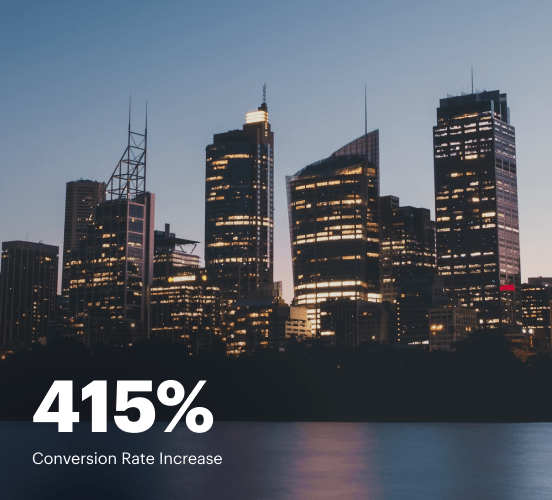Typeform vs. Webflow: the best platform for a seamless web experience
Discover how Typeform compares to Webflow regarding features and usability. Find out which platform provides the competitive advantage your business deserves.
Get startedSee how Instapage stacks up against the competition
| Feature | Instapage | Other builders |
| Drag-and-Drop Tools | ||
| Conversion-optimized templates | ||
| Manual and AI-powered A/B Tests | ||
| AI content suggestions | ||
| Popups and sticky bars | ||
| Canvas and grid blocks | ||
| Reusable and global elements | ||
| Form and popup builders | ||
| Built-in Heatmaps | ||
| Central analytics dashboard | ||
| Ad-to-page personalization and collections | ||
| Contacts, lists, and email | ||
| Dedicated, full-service CRO experts | ||
| Enterprise-ready platform |
Leading the way in building high-performing landing pages





Why Instapage is the smarter choice for your campaigns
Get everything you need to build, scale, and optimize high-converting landing pages—without coding.

Easier page building without coding
Instapage offers a flexible and seamless page creation experience with a library of 500+ conversion-focused layouts, Instablocks®, a drag-and-drop builder, and AI content generation. With technologies like Thor Render Engine®, you can create on-brand, mobile-responsive landing pages that load quickly and start converting during initial visitor clicks.

More insights — better results
Instapage lets you see in detail how each landing page experience and variation is performing so you can make targeted changes that boost page conversions. Use heatmaps for a better understanding of on-page activities, run A/B tests and AI-assisted experiments, and then track and evaluate results within robust analytics dashboards.

More personalized experiences
Instapage lets you quickly create high-performing landing pages tailored to each of your ad campaigns. Deliver personalized experiences for distinct audiences using dynamic text replacement. Effortlessly align specific advertisements to unique pages with AdMaps. Monitor audience-level metrics using our advanced data tools.

Built-in collaboration
Instapage collaboration capabilities bring your entire team together to speed up the process of landing page review, approval, and launch. No more frustrating and unnecessary revisions or edits scattered across emails. Provide instant feedback, conduct real-time page edits, and securely share your pages with outside stakeholders.

Free up time for your business
Invest time into business growth, not busy work. Launch landing pages faster with reusable forms and templates. Build once, reuse forever.
Explore all integrations






Easier page building without coding
Instapage offers a flexible and seamless page creation experience with a library of 500+ conversion-focused layouts, Instablocks®, a drag-and-drop builder, and AI content generation. With technologies like Thor Render Engine®, you can create on-brand, mobile-responsive landing pages that load quickly and start converting during initial visitor clicks.
More insights — better results
Instapage lets you see in detail how each landing page experience and variation is performing so you can make targeted changes that boost page conversions. Use heatmaps for a better understanding of on-page activities, run A/B tests and AI-assisted experiments, and then track and evaluate results within robust analytics dashboards.
More personalized experiences
Instapage lets you quickly create high-performing landing pages tailored to each of your ad campaigns. Deliver personalized experiences for distinct audiences using dynamic text replacement. Effortlessly align specific advertisements to unique pages with AdMaps. Monitor audience-level metrics using our advanced data tools.
Built-in collaboration
Instapage collaboration capabilities bring your entire team together to speed up the process of landing page review, approval, and launch. No more frustrating and unnecessary revisions or edits scattered across emails. Provide instant feedback, conduct real-time page edits, and securely share your pages with outside stakeholders.
Free up time for your business
Invest time into business growth, not busy work. Launch landing pages faster with reusable forms and templates. Build once, reuse forever.
Explore all integrationsGet started with Instapage in a few steps
-
Create your Instapage account
Start with Instapage by signing up via Google or your email. You'll get access to a free 14-day trial to discover Instapage capabilities. Feel free to cancel anytime during the 14-day trial if you decide that our product is not suitable for your business. -
Build and personalize your page
Create your first landing page from scratch or choose a template from 500+ customizable layouts. Use the drag-and-drop builder to add page elements, fonts, and backgrounds, refine content with AI, or add custom HTML, Javascript, and CSS. -
Review and make edits
Collaborate on page designs and streamline review processes. Invite your team members and stakeholders to review, edit, and provide feedback on your landing page. Collaborate knowing your page is confidential and only accessible to authorized users. -
Publish and track page performance
Publish your page to a domain or custom URL. Connect your pages to the ads you've created and track page performance within the analytics dashboard, run A/B tests and AI experiments, analyze results, and continuously optimize your landing page to maintain high conversions.
Typeform vs. Webflow: A Battle of Digital Titans
As we kick off this exciting showdown, the world of landing page and form creation beckons marketers and businesses alike. With endless options available, narrowing down the best tools for your needs can feel overwhelming. Enter Typeform and Webflow, two powerful platforms that have carved out niches for themselves in the crowded digital landscape. Typeform stands tall with its engaging forms and surveys that prioritize user experience, while Webflow flexes its muscles as a customizable website builder that empowers users to create stunning pages without a single line of code. This article will unveil the strengths and weaknesses of both platforms, while also introducing you to another formidable contender in the ring—Instapage. Buckle up as we explore each platform’s features and uncover what makes them stand out, ultimately helping you make the right choice for your business needs.
Introducing the Contenders
In our left corner, we have Typeform—a user-friendly platform known for its visually engaging forms and surveys that can help boost customer engagement and data collection. Launched in 2012, Typeform has gained popularity for its sleek interface and unique approach to interactivity, ensuring that users feel more like participants than respondents. It’s all about gathering opinions and insights in a pleasant way. In the opposing corner is Webflow, a robust website design tool that gives users the ability to create and manage fully responsive websites without needing to learn HTML or CSS. Launched in 2013, Webflow emerged as a go-to choice for designers who want to balance aesthetic appeal with high functionality. Both platforms bring their unique flair to the arena, but there’s an intriguing third player waiting in the wings. Instapage, the unsung hero of landing page tools, offers a tailored experience that caters specifically to marketers looking to boost conversion rates. As we go through the rounds of this showdown, keep an eye out for what makes each platform a heavyweight in the digital marketing world.
Round 1: Features Face-off
The first round features a clash of capabilities, as Typeform and Webflow showcase their best attributes. Typeform dazzles with its interactive forms designed to provide a seamless experience, allowing businesses to gather information effectively. Not just your average questionnaire, Typeform allows for customization that makes each interaction feel less robotic and more genuine—a key aspect in engaging users. On the flip side, Webflow strikes back with its extensive feature set that provides design freedom and flexibility. Its responsive design capabilities ensure that any website built is visually appealing on any screen size, and with the addition of CMS capabilities, even the largest content-heavy sites can be managed effortlessly. Both platforms are impressive in their own right, but as the competition heats up, a familiar name lurks backstage—Instapage, which promises a unique spin on landing pages that might just outshine both.
Round 2: Usability Uncovered
As we explore the usability of our contenders, it's essential to consider how each platform caters to its user base. Typeform positions itself as a platform that welcomes beginner marketers, making it easy to create forms with little to no technical know-how. Newbies can jump right in, navigating the intuitive interface like pros, while seasoned marketers appreciate the depth of customization available for advanced users. In the meantime, Webflow offers a more complex experience, appealing to designers and developers who feel at home in the digital realm. However, it can pose a learning curve for those unfamiliar with design principles—which some might find more of a learning adventure than a daunting obstacle. With a community of passionate users and extensive resources, mastering Webflow can be a rewarding journey, but prepare to invest some time upfront.
Typeform Features:
- Interactive and engaging form design that boosts user participation
- Customizable templates catering to various business needs
- Real-time responses that allow for immediate feedback and data collection
- Integration capabilities with popular tools like Google Sheets and Zapier
- Mobile-friendly interface ensuring accessibility on all devices
Webflow Features:
- Design flexibility that allows for unique and tailor-made website layouts
- Responsive design tools that adapt across devices
- Built-in content management system (CMS) for dynamic content
- E-commerce options for businesses looking to set up online stores
Common Strengths of Typeform and Webflow
- User-friendly interfaces that simplify complex tasks
- Helpful integration options to connect with other tools
- Strong focus on enhancing user experience
- Accessibility features for users of all abilities
- Analytics & tracking tools to measure effectiveness
- Dedicated customer support to guide users through challenges
In this exhilarating bout, both Typeform and Webflow showcase their unique strengths. Each is impressive, yet as we unveil Instapage, it emerges as a game-changing competitor that combines the best features of both. While Typeform excels in engagement and user feedback, and Webflow dominates in design flexibility, Instapage strategizes for a more focused outcome—higher conversion rates. It’s a cheeky reminder that while both Typeform and Webflow have their merits, Instapage can be the ace up your sleeve in the competitive landscape of digital marketing.
Round 3: Performance Comparison
As we roll into round three, performance takes center stage. Page loading times are critical in the digital arena; slow-loading sites can crush user interest faster than a flash knock-out. Typeform does an admirable job here, with forms loading swiftly, maintaining user engagement effectively. In contrast, Webflow’s robust designs can occasionally lead to longer loading times, particularly if heavy visuals are used without optimization. Imagine trying to run a race in heavy boots—it's not ideal! Moreover, in today's mobile-first world, both platforms recognize the importance of responsiveness. Typeform is designed to be mobile-friendly, while Webflow’s extensive tools allow for the creation of mobile-first designs, enabling users to ensure their sites look great on any screen. However, users should remain mindful of optimizing their visuals and scripts to maintain speed.
Round 4: Support Resources Showdown
In any platform battle, a solid support system can be the difference between success and struggle. Typeform boasts a rich library of resources and a friendly support team that ensures users have a smooth experience. It offers helpful guides and tutorials covering various functionalities, allowing users to get answers quickly. Webflow also offers insightful resources, including a community forum, tutorials, and detailed documentation catering to users with different levels of experience. Their customer support team is known for being responsive, ready to leap in and assist when challenges arise. Whether you are a beginner just starting or an expert looking to refine your skills, both platforms provide ample support—though the user experience may vary, and each community brings its unique vibe.
Round 5: Pricing Showdown
Typeform Pricing Hierarchy Benefits:
- Various pricing tiers catering to different business needs
- Free version available with decent features for small projects
- Pay-as-you-go options for sporadic users
- Affordable plans for businesses scaling their content needs
Webflow Pricing Hierarchy Benefits:
- Flexible pricing plans, accommodating everything from freelancers to enterprises
- Free tier available, although with some limitations
- Affordable packages for small businesses up to advanced options for larger teams
- Additional features available as add-ons, allowing customization
Examining the pricing strategies reveals that both Typeform and Webflow tailor plans to suit various user needs, but it's important to also consider Instapage as a worthy alternative. Instapage stands out with its focused offerings geared specifically towards optimizing the conversion process—often considered the best value for money. While Typeform and Webflow provide flexibility in their pricing, Instapage takes that up a notch with unique features designed to maximize ROI for marketers.
Notably, understanding the pricing schemes can sometimes be a puzzle. Each platform offers clear tiers, however, one must consider the fine print where hidden costs may lie in wait. It’s a cheeky reality that the most glamorous options might not always be the best deals; surprises often lurk in the shadows of marketing tools, and savvy users will read the details closely.
And Then Enter Instapage...
Bringing the spotlight to Instapage, we highlight this platform as the mentor who’s been quietly observing, ready to shine. With a sole focus on landing pages and conversion optimization, Instapage provides unique value propositions that fill gaps left by both Typeform and Webflow. Its collaborative features streamline workflows, allowing teams to create and manage landing pages efficiently. Additionally, Instapage’s robust A/B testing capabilities enable users to assess which designs and messages resonate most with their audience—something Typeform and Webflow struggle to deliver on the same level. As businesses navigate the dynamic landscape of digital marketing, Instapage emerges as a vital player that provides focused strategies geared toward driving results without the overwhelming assortment that other platforms can present. Making informed choices is paramount, and Instapage could just be the secret weapon that elevates a marketing strategy to new heights.
As we wrap up this exploration, it’s essential to emphasize the power of informed decision-making in selecting the right platform. Each of these tools has something unique to offer, so it’s crucial to consider what aligns best with personal or business goals. Be it through engaging forms, stunning websites, or tailored landing pages, these platforms can help spearhead your digital efforts. With Instapage positioned as the next logical step on this journey, I encourage readers to take the leap and explore the possibilities that await.










